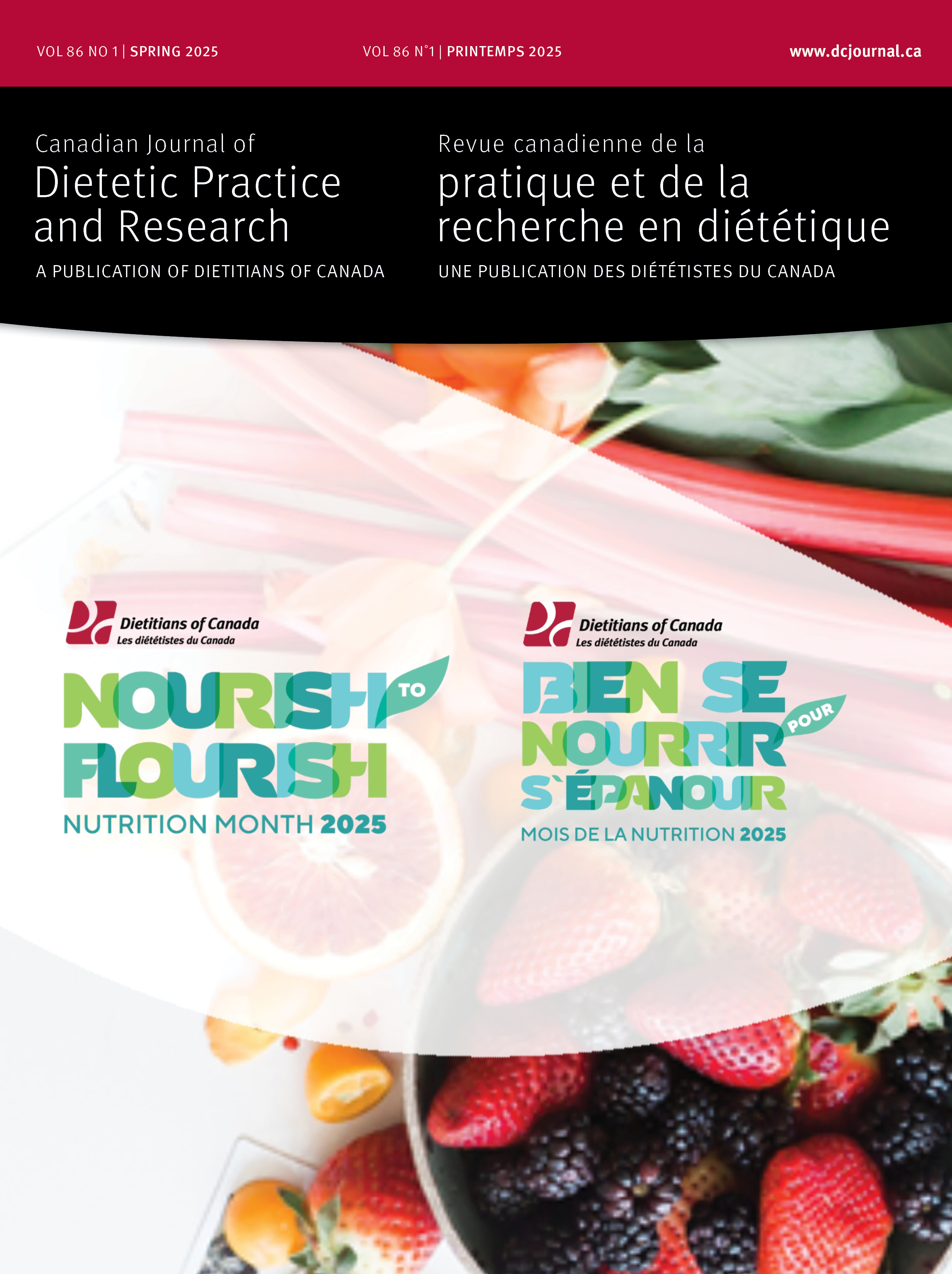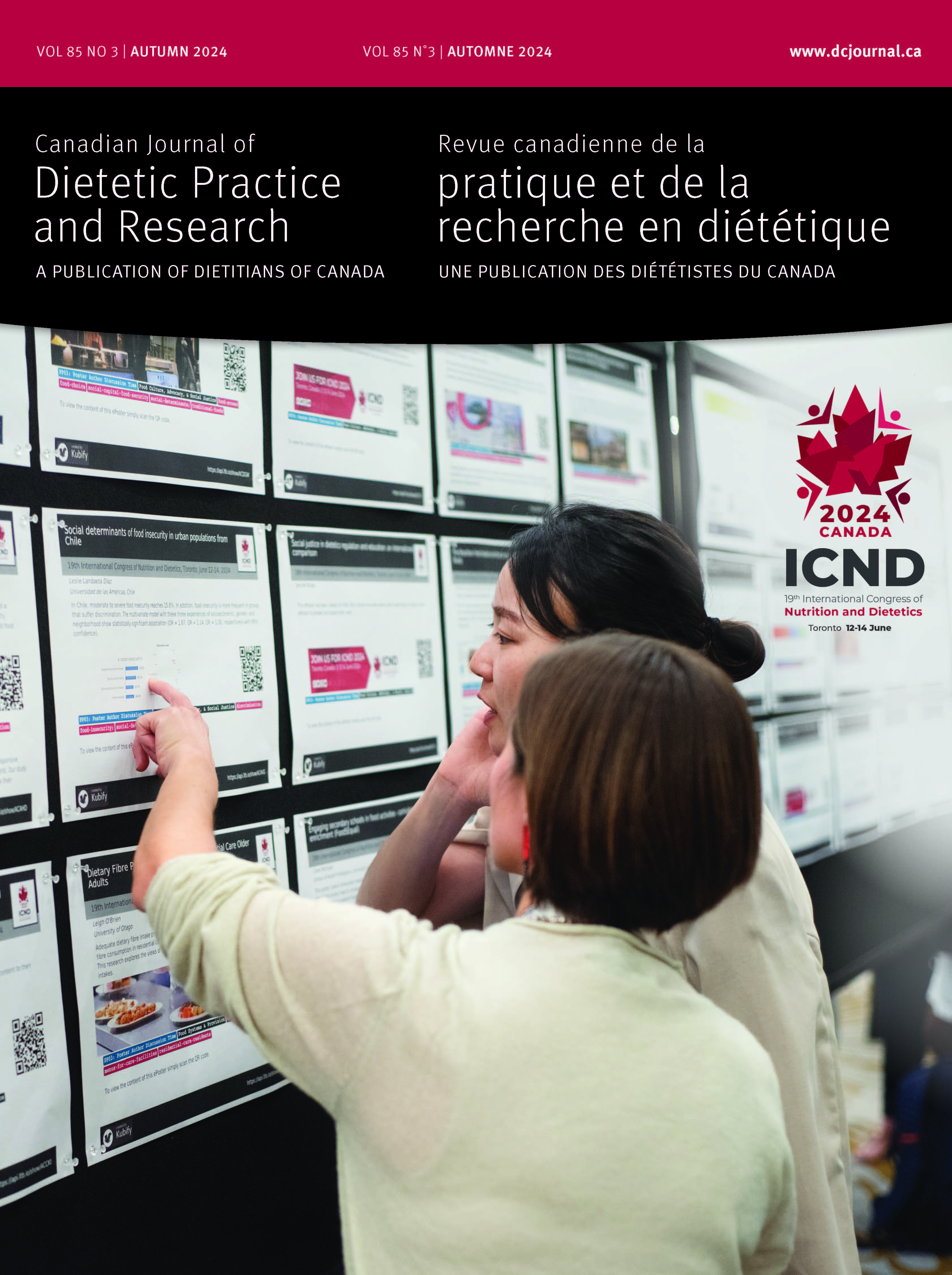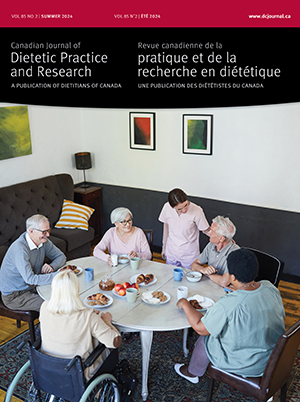Volume 83 • Number 2 • June 2022
Editor’s Message
Research
Purpose: To evaluate foods advertised in discount and premium grocery flyers for their alignment with Canada’s 2007 Food Guide (CFG) and assess if alignment differed by food category, season, page location, and price.Methods: Weekly flyers (n = 192) were collected from discount and premium grocery chains from each of 4 seasons. Health Canada’s Surveillance Tool was used to assess food items as in-line or not in-line with CFG.Results: Of 35 576 food items, 39.7% were in-line with CFG. There were no differences in proportions of foods not in-line in discount versus premium flyers (60.9% and 60.0%, respectively). Other Foods and Meat & Alternatives were advertised most (28.0% and 26.3%, respectively; P < 0.001). Milk & Alternatives were the least advertised food group (10.3%). Vegetables & Fruit (19.6%), Grains (21.6%), Milk & Alternatives (20.6%), and Meat & Alternatives (20.2%) were promoted least in Fall (P < 0.001). A higher proportion of foods advertised on middle pages were not in-line (61.0%) compared with front (56.6%) and back (58.8%) pages (P < 0.001). Not in-line foods were more expensive ($3.49, IQR = $2.82) than in-line foods ($3.28, IQR = $2.81; P < 0.001).Conclusions: While there was no difference in healthfulness of foods advertised in discount versus premium flyers, grocers advertised more foods not in-line with CFG. Government policies to improve the food environment should consider grocery flyers.
Purpose: Knowledge is fundamental to helping children make nutritional choices that support lifelong healthy behaviours. This study (i) investigates elementary school children’s knowledge about food and nutrition and (ii) identifies sociodemographic factors influencing children’s reported knowledge.Methods: In 2017–2019, a survey was administered to 2443 students (grades 5–8) at 60 schools across southwestern Ontario, Canada, and a parent survey was used to validate self-reported sociodemographics. Multiple regression was used to analyse children’s knowledge scores and related sociodemographic factors. A total knowledge score was calculated by summing correct responses derived from 46 individual questions in the student survey.Results: Mean total knowledge score was 29.2 out of a possible 46 points (63.5% correct). Students demonstrated some knowledge and awareness of strategies to encourage fruit and vegetable consumption, healthy food selection, nutrition, and food preparation skills, although knowledge of food guide recommendations and locally sourced produce were limited. Female sex, family income, and rurality were associated with higher knowledge scores.Conclusions: Results provide insight regarding strengths and gaps in elementary-school children’s food and nutrition knowledge. Poor performance of students on specific food guide-related questions suggests that the general guidance of the 2019 Canada’s Food Guide might be better understood by children and adolescents.
Perspectives in practice
Upon moving to a new country and new food environment, 2 important public health issues may be experienced by immigrants as they adapt to their new country of residence, namely a higher prevalence of food insecurity and/or a decline in overall health over time postimmigration. Therefore, improving the food environment experienced by new migrants may be an effective strategy to reduce long-term health complications and improve well-being postimmigration. The aim of this paper is to discuss the potential barriers experienced by new immigrants in the access, availability, and utilization of familiar culturally appropriate foods and the subsequent impact on their food security status. Culturally appropriate foods are foods commonly consumed as part of cultural food traditions and are often staples within the diet; however, limited availability of and/or access to these foods can reduce food security. By understanding the barriers to food security and challenges that may be faced by immigrants and refugees, dietitians will be better equipped to assist these individuals in accessing culturally familiar foods and improve quality of life. In this capacity, dietitians can play a critical public health nutrition role by serving as a conduit for new immigrants to access community resources and navigate a new food environment.
OPEN ACCESS
Various definitions have been proposed to describe Medical Nutrition Therapy (MNT). Broadly, MNT encompasses the provision of nutrition information and advice aimed to prevent, treat, and/or manage health conditions. In Canada, the provision of such information and advice is unregulated, thus allowing anyone to provide MNT services regardless of their education and training. This inevitably poses risks of harm such as the provision of unsafe and/or ineffective nutrition advice as well as delayed evidence-based treatment. Canadian research has further demonstrated that the general public is unable to properly differentiate between regulated, evidence-based nutrition providers (registered dietitians) and those who are unregulated. Therefore, the public is at risk. To reduce nutrition misinformation and ultimately improve the health and well-being of the public, the objective of this paper is, first, to propose a standardized definition of MNT for use across Canada and, second, to propose province- and territory-specific legislative amendments for the regulation of MNT throughout the country. We also present an opposing perspective to the proposed viewpoint. Ultimately, health care regulation across the country requires an overhaul before we expect that nutrition information and advice communicated to the public may be consistently evidence based.
What Practice Issues Over 25 Years Most Interest Registered Dietitians? Survey and Interview Results
Dietetics has changed substantially; a mixed-methods project was undertaken to: (i) gauge interest in the profession history since 1993, (ii) identify preferred format(s), (iii) identify possible topics, and (iv) identify possible key informants. An online bilingual survey was conducted in 2018, with follow-up phone interviews among interested respondents. Survey content was organised as 12 major topics. Respondents were invited via a Dietitians of Canada (DC) newsletter, Facebook groups, and at the DC national conference. Survey data, including respondent-generated topics of interest and interview content, were descriptively analyzed. The online survey garnered 360 responses; 332 (92%) completed more than 10% of the survey and were interested in history. Detailed responses were analyzed (296 English; 36 French); 51 were interviewed. An online timeline was the most preferred format (79%). Review of the rise in technology and obesity, aging, supermarket registered dietitians (RDs), the local/organic movement, Practice-based Evidence in Nutrition (PEN), the changes in training models and scope of practice, public awareness of the profession, and advocacy and unique career paths were of most interest (≥ 50% of respondents). These results confirm interest in the recent history of the profession among RDs and provide guidance on preferred format and topics for further work.
There is limited data on the effects of cooking classes on male participants. The LiveWell Chronic Disease Management program’s Men’s Cooking Class (MCC) aims to help participants gain skills and confidence with food to manage chronic diseases more independently and improve their health. This paper evaluates whether, and how, the program is effective in achieving its goals.A qualitative process was used to collect data from past program participants. Data collection included telephone interviews conducted with a sample of 27 past MCC attendees and a focus group held with a subsample of seven participants. Thematic analysis was performed on collected data.Five major themes emerged, including (i) practical and applicable content, (ii) kinesthetic teaching and learning, (iii) catering to the interests of participants, (iv) tailoring to the demographic, and (v) enjoyment and engagement. Findings indicate the current LiveWell MCC program is effective in meeting its goals. The themes identified are aspects of the program that contribute to this effectiveness.The thematic findings indicate areas in which to continuously adapt and monitor the effectiveness of this program and serve as recommendations for other programming. Further research on the long-term impact of MCC for self-management of chronic disease is needed.
Review
Understanding how patients perceive their health and the experience with the dietitian is fundamental to providing patient-centred care. The types of patient reported measures (PRMs) used by outpatient dietitians is unclear. Guidance about use of PRMs for dietitians is also lacking. The aim of this systematic review was to synthesise evidence regarding the use of PRMs by dietitians in the outpatient setting and evaluate the methodological quality of studies evaluating the psychometric properties of PRMs. Eight databases were searched systematically for studies of dietitians working in the outpatient setting and administering a PRM. Forty-four studies were evaluated and described 58 different PRMs. These included direct nutrition related (n = 12 studies), clinical (n = 21 studies), and health-related quality of life PRMs (n = 24 studies); 1 study documented use of a patient-reported experience measure. A large range of PRMs are used by outpatient dietitians. Of the most common PRMs, the majority are administered in similar populations to the original validation study. Dietitians should use a combination of 3 PRMs: a generic health-related quality of life tool, an experience measure, and at least 1 clinical or direct nutrition-related measure. This will enable dietitians to fully capture the impact of their care on patients.










